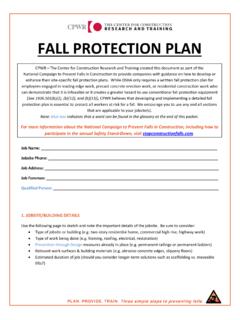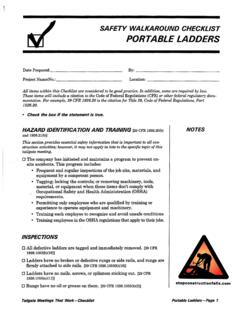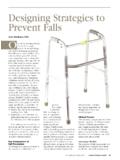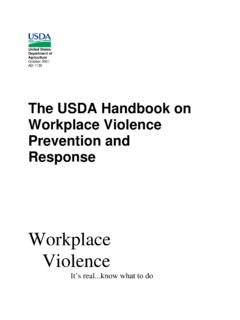Transcription of Preventing Falls from Ladders in Construction
1 Preventing Falls from Ladders in Construction A Guide to Training Site Supervisors Harvard School of Public Health, Department of Environmental Health Preventing Falls from Ladders in Construction HARVARD. School of Public Health Department of Environmental Health 665 Huntington Avenue Boston, MA 02115. phone fax Melissa J. Perry, ScD, MHS, Principal Investigator Christopher J. Ronk, MS, Project Coordinator 2010, HSPH - Harvard School of Public Health. All rights reserved. Research for this report was funded by CPWR The Center for Construction Research and Training, using grant U54 OH008307 from the National Institute of Occupational Safety and Health (NIOSH). The contents are solely the responsibility of the authors and do not necessarily represent the official views of NIOSH, HSPH, or CPWR. The cover photo shows an example of a worker accessing a ladder safely. Photo credit: NIOSH/John Table of Contents ladder Safety Study 7. About This Manual 7. ladder Safety Rationale 7. Focus on Ladders and Superintendents 7.
2 Theory and Conceptual Foundation 7. Intervention Learning Objectives for Superintendents 8. ladder Safety Study Design 10. ladder Safety Study Results 10. ladder Safety Study Investigators and Advisors 11. Research Presentations and Articles Originating from the Study 11. Module I: ladder Falls Knowledge 13. Module II: Personal Susceptibility 17. Module III: Peer Norms 20. Module IV: Skills Training 21. Appendices 27. Appendix 1: Proper ladder Setup Dimensions 27. Appendix 2: ladder Safety Knowledge Questions 28. Appendix 3: Guidelines for Extension ladder Safety 30. Appendix 4: Combined Results of All Sites of Companies Visited 32. Appendix 5: Communication Skills Case Vignette 37. ladder Safety Study About This Manual ladder Safety Rationale Focus on Ladders and Superintendents Theory and Conceptual Foundation Intervention Learning Objectives for Superintendents ladder Safety Study Design ladder Safety Study Results ladder Safety Study Investigators and Advisors Research Presentations and Articles Originating from the Study About This Manual This manual has two objectives.
3 The first is to describe how the ladder Safety Study was conducted and to present the results. The second is to provide the Intervention Program content and supporting materials as a guide for safety practitioners who would like to conduct an effective ladder -training session. ladder Safety Rationale The goal of this study was to reduce the incidence of Falls from portable Construction Ladders . The project built on prior and ongoing surveillance efforts on ladder -related injuries by moving the research into the development and evaluation of interventions. There are still many unknowns about Falls in Construction , and the most effective approaches to Preventing Falls from Ladders are not yet clear. We conducted a two-stage study undertaking pre- intervention research to develop an intervention plan based on sound scientific evidence and following it by implementing a program to evaluate both its feasibility and success in increasing knowledge and safety behaviors. Focus on Ladders and Superintendents Our focus on Ladders was intended to be a highly directed approach targeting a well-known source of Falls .
4 Including a specific focus on step Ladders addressed a commonly overlooked special context for injury. Both worksites and workers were intervention targets; however, our primary aim was to not employ the usual change the worker approach to injury prevention but rather to target work-specific and jobsite-specific contexts that can increase risk of Falls . Because superintendents exert major influences over their worksites, we assumed that increasing their knowledge and changing their attitudes and risk perceptions would also have an impact on their workers. The superintendents would serve as positive models for safety behavior and high-risk ladder work substitution. Theory and Conceptual Foundation To achieve behavior change, we focused on several factors known to influence health behavior change (Bunton et al., 1991). These factors have been shown to be influential in many other health promotion programs. However, to the best of our knowledge, this was the first project to apply these concepts to Construction injuries.
5 Knowledge of the risks associated with health-compromising behaviors has been identified as necessary but not sufficient to result in behavior change (Edwards et al., 1990). Risk perception, a belief in one's susceptibility for disease or injury, has also been identified as a necessary prerequisite for changing health behaviors (Weinstein, 1987). An individual's perception of peer norms, which define the perceived acceptability of a behavior among friends and peers, influences whether someone will practice safer behaviors (Rogers, 2003). Self-efficacy beliefs or beliefs in one's ability to make the behavior change are also highly predictive of actual behavior change (Bandura, 1986). 7. Intervention Learning Objectives for Superintendents Our safety training for superintendents emphasized: a) major sources and contexts for Falls from portable Ladders in the workplace (hazards); b) strategies to routinely identify worksite-related ladder hazards; c) strategies to routinely identify job-related ladder hazards; d) ways to replace high-risk ladder work tasks with lower risk alternatives ( , bucket hoists and scaffolding); and e) strategies to teach and model safety behavior to workers.
6 We emphasized ways to organize work to reduce high-risk tasks, to communicate hazard information to workers without lecturing them, and to model safety knowledge and behavior by using I statements that illustrate how one incorporates safety tips into work practices ( , I have learned one of the best ways to stay safe on the ladder is to always maintain three points of contact. ). Worksite superintendents, given the many demands on them, do not always consider safety as their first priority. They need training to raise their awareness and perceived risk of ladder injuries before they are ready to train and model skills to their workers. Therefore, the rationale for ladder awareness was built using the following intervention components: I. Knowledge of ladder -associated risks (p. 13). Current statistics on injuries and Falls in Construction have been summarized into a presentation designed for nonscientific audiences. It highlights epidemiologic data on fatal and nonfatal severe ladder injuries and what is currently known about fall prevention in general.
7 For example, nearly one quarter of nonfatal Falls in Construction are related to ladder use, and 38% of ladder is not correctly supported and is incorrectly angled. All non-self- supporting Ladders should be secured at the top to prevent movement. Ladders should be placed at a 75-degree angle or a 4:1 ratio of ladder length to top support point to distance of ladder base from wall. For a ladder length to support point of 20 feet, the base should be 5 feet from the wall. The ladder should extend 36 inches above landing point. There are no guard rails on scaffold, and planking extends too far over supports. Area below scaffolding shows bad housekeeping. Photo credit: OSHA Training Institute, Southwest Education Center/ 8 Preventing Falls from Ladders in Construction Construction fatalities are due to Falls , compared to only 15% in general industry (CPWR, 2008; Bureau of Labor Statistics, 2007). In this presentation we also emphasize the results from our pre-intervention research, including our study of ladder Falls treated in emergency rooms (Brennan et al.)
8 , 2008) and the worksite observations we conducted at 18 sites in eastern Massachusetts. This information was new to most participants in our study, and we presented it to heighten awareness and risk perception. II. Susceptibility to ladder hazards (p. 17). Slides illustrating common ladder -handling problems were shown to superintendents in order to give concrete examples of how hazards occur, how to identify them, and lower risk alternatives to high-risk ladder work tasks. Presented in conjunction with the statistics and epidemiology of ladder Falls , this information was intended to increase motivation to practice safe ladder handling routines and vigilance in identifying worksite hazards. The CPWR video, Don't fall for It! (2006), details real-life stories of fall experiences and was also used to heighten awareness of injury susceptibility. III. Peer norms for safe ladder handling ( ). We discussed how respected local companies have altered their job routines to avoid doing high-risk job tasks on Ladders , to incorporate safe ladder handling into their job routines, and to communicate this information to the workers they oversee.
9 This component of the intervention assumed that using well-regarded members of a peer group ( , managers in a shared trade and work region) to model the desired behavior change ( , reduce reliance on Ladders and switch to lifts) would encourage behavior change among the superintendents. The discussion included an overview of current industry standards and examples of how the new practices introduced by some companies to reduce ladder risks may be changing safety norms throughout the Construction industry. IV. Skills training to increase self-efficacy beliefs (p. 21). The training included time spent reviewing specific practices that can decrease ladder hazards including the Three Points of Contact Rule and the Belt Buckle Rule to teach specific skills that superintendents can communicate to and reinforce with workers. One objective of this component of the session was to give superintendents time to acquire the skills necessary to practice safe ladder handling procedures so that they could model them to their workers.
10 If the superintendents perceived they had learned some new skills, self- efficacy beliefs for safe ladder handling were likely to increase as well. The other key objective was to give superintendents an opportunity to practice alternative forms of communication to guide workers rather than alienate them. ladder is placed incorrectly. If possible, worker should be facing operation. This is an unsafe, awkward work posture. Photo credit: NIOSH/John 9. ladder Safety Study Design The following diagram explains how the ladder Safety Study was designed: 1. 18 Worksites from 8 individual companies were included. 1 3 5 7 2 4 6 8. 1|2 3|4 5|6|7 8 | 9 | 10 11 | 12 1 3 | 14 1 5 | 16 17 | 18. 2. Worksites were randomized. Intervention Arm Control Arm Companies n=4 Companies n=4. Worksites n=10 Worksites n=8. Step Ladders n=302 Step Ladders n=286. 3. Baseline assessment was conducted. Worksite Audits Superintendent Assessments Step ladder Assessments 4. Intervention was delivered. ladder Intervention Program Standard Treatment 5.







